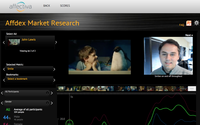
When it comes to delivering advertising results, most
marketers agree creative execution is the most impactful lever to pull.
At the top of the creative food chain, TV still reigns supreme, with digital video (the fastest-growing media channel)
now playing a similar role in audience engagement. More than ever, marketers need to understand how to best leverage video for their brands -- and AI is playing an important role in that task.
Multiple studies have shown that advertising geared toward stimulating an emotional response is significantly more effective than value-driven advertising, which is why many brand marketers have
gotten religious about creating video content that moves people to smile, laugh, cry or be surprised.
This is obviously where the art of advertising is alive and well --
talented creative directors need not fear being replaced by AI any time soon. But the science of emotional advertising is also emerging. Brand marketers and agencies that take this seriously
are using AI technology to measure the emotional effectiveness of their creative.
advertisement
advertisement
One such technology solution, Affectiva, employs facial analysis to understand how viewers react to
advertising content on a second-by-second basis.
In this way, marketers can know the relative emotional effect achieved by different executions of their advertising over time, as
well as which segments of their video should remain in shortened versions.
Producers also often use this kind of testing during creative development to ensure they are hitting the
mark. Like other forms of advertising that are measured, we will soon have broader industry benchmarks and KPIs around emotion. Affectiva’s founder and CEO, Rana El Kaliouby
explains, “Now that we have enough data, we can start to build norms for categories. How do people typically respond to chocolate ads, for instance?”
The Affectiva platform
uses a panel of 150 to 200 people to test each campaign, and captures expressions that indicate intensity of emotion as video content is watched. The facial coding technology can even
distinguish a frustrated smile from one of joy, so the resulting graph tells a nuanced story.
If you have a half hour, I strongly recommend watching Graham Page, head of global research
for Kantar Millward Brown, present “Building the Emotionally Intelligent Brand,” which discusses how
his company is using this technology to help track and improve creative success.
Graham shows examples of emotive advertising, including “Buster the Boxer" from U.K. retailer John Lewis. This is an emotionally powerful piece that graphs a building response as the story
unfolds, depicted by smiles that ultimately go “off the chart” compared to norms seen by the Kantar Millward Brown team. Such successful ads are used to dissect the formula for
conjuring emotion -- developing relationships between people or animals, for instance.
“Ads that have a positive dynamic and take you through an emotional journey have a strong
correlation with sales, especially if they end on a positive note,” offers El Kaliouby.
AI technology is also playing a role tracking TV-viewing behavior to measure attention paid
to ads and programming content. TVision Insights (disclosure: I am an angel investor) uses 3-D infrared computer vision to observe TV viewers in their homes, where attention can easily be
diverted to smaller screens or other activities. Viewing insights are recorded via Nielsen-like boxes that help to report on the success of ads in garnering attention. This is another
determinant in grading the quality of advertising creative, and also the stickiness of programming content.
Aside from understanding which shows and ads are watched attentively, TVision
Insights makes it possible to know exactly who is in the room and how group watching affects attention. Advertisers and programmers are using this data to learn about co-viewing as a key factor
in ad watching. “We know for instance that if adults are watching TV with children, they are less likely to leave the room while a show is in progress,” says TVision Insights CEO,
Yan Liu.
This type of insight can lead to more value being assigned to certain types of programming content. Liu also refers to viewing insights that compare shorter spots relative to
longer ones, especially as YouTube and Facebook become more prevalent on TV screens. Will six-second spots be more successful than 15- and 30-second spots in holding attention?
Ultimately, AI technologies that help unlock the psychology of advertising offer important insights into making TV and video creative more effective, improving
advertising and programming over
time.
If that feels like a better TV-watching experience, I’ll second that emotion.